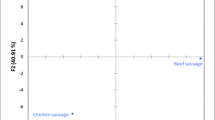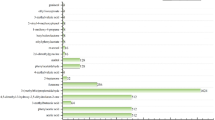Abstract
In order to elucidate the differences on aroma compounds in Chinese liquors with different aroma styles and the reasons, aroma compounds of Xijiu in soy sauce aroma and strong aroma type were investigated in the research. By gas chromatography–olfactometry (GC–O), aroma compounds in Chinese liquor were chosen for quantitative and odor activity value (OAV) analysis. Ethyl hexanoate, butanoic acid, 3-methylbutanoic acid, hexanoic acid and dimethyl trisulfide were considered to be the most powerful odorants in both liquor samples (aroma intensity ≥3.5) by GC–O. As important aroma compounds (OAV ≥10) in the liquors, ethyl propanoate, ethyl 2-methylpropanoate and 1-propanol were considered with much higher OAVs in soy sauce aroma type liquor, while OAVs of ethyl pentanoate, ethyl hexanoate, ethyl heptanoate, ethyl octanoate, ethyl lactate, hexyl acetate, butyl hexanoate, hexyl hexanoate and hexanoic acid were far lower in strong aroma type liquor. The OAV of ethyl hexanoate in strong aroma type liquor exceeded 50,000, which explained the reason why strong aroma liquor was considered with prominent fruity aroma. The odor differences between the liquors were mainly caused by the manufacturing practices.



Similar content being viewed by others
References
Fan W, Qian MC (2006) Identification of aroma compounds in Chinese ‘Yanghe Daqu’ liquor by normal phase chromatography fractionation followed by gas chromatography/olfactometry. Flavour Fragr J 21(2):333–342
Fan W, Shen H, Xu Y (2011) Quantification of volatile compounds in Chinese soy sauce aroma type liquor by stir bar sorptive extraction and gas chromatography–mass spectrometry. J Sci Food Agric 91(7):1187–1198
Fan W, Xu Y, Qian MC (2012) Identification of aroma compounds in Chinese “Moutai” and “Langjiu” liquors by normal phase liquid chromatography fractionation followed by gas chromatography/olfactometry. In: Qian MC, Shellhammer TH (eds) Flavor chemistry of wine and other alcoholic beverages. ACS symposium series, vol 1104. American Chemical Society, Washington, pp 303–338
Zhu S, Lu X, Ji K, Guo K, Li Y, Wu C, Xu G (2007) Characterization of flavor compounds in Chinese liquor Moutai by comprehensive two-dimensional gas chromatography/time-of-flight mass spectrometry. Anal Chim Acta 597(2):340–348
Fan W, Xu Y, Zhang Y (2007) Characterization of pyrazines in some Chinese liquors and their approximate concentrations. J Agric Food Chem 55(24):9956–9962
Fan W, Qian MC (2005) Headspace solid phase microextraction (HS–SPME) and gas chromatography–olfactometry dilution analysis of young and aged Chinese ‘Yanghe Daqu’ liquors. J Agric Food Chem 53(20):7931–7938
Jiang B, Xi Z, Luo M, Zhang Z (2013) Comparison on aroma compounds in Cabernet Sauvignon and Merlot wines from four wine grape-growing regions in China. Food Res Int 51(2):482–489
Luo T, Fan W, Xu Y (2008) Characterization of volatile and semi-volatile compounds in Chinese rice wines by headspace solid phase microextraction followed by gas chromatography–mass spectrometry. J Inst Brew 114(2):172–179
Chen S, Xu Y, Qian MC (2013) Aroma characterization of Chinese rice wine by gas chromatography–olfactometry, chemical quantitative analysis, and aroma reconstitution. J Agric Food Chem 61(47):11295–11302
Fan W, Xu Y, Jiang W, Li J (2010) Identification and quantification of impact aroma compounds in 4 nonfloral Vitis vinifera varieties grapes. J Food Sci 75(1):S81–S88
Grosch W (2001) Evaluation of the key odorants of foods by dilution experiments, aroma models and omission. Chem Senses 26(5):533–545
Langos D, Granvogl M, Schieberle P (2013) Characterization of the key aroma compounds in two bavarian wheat beers by means of the sensomics approach. J Agric Food Chem 61(47):11303–11311
Poisson L, Schieberle P (2008) Characterization of the key aroma compounds in an American Bourbon whisky by quantitative measurements, aroma recombination, and omission studies. J Agric Food Chem 56(14):5820–5826
Czerny M, Christlbauer M, Christlbauer M, Fischer A, Granvogl M, Hammer M, Hartl C, Hernandez NM, Schieberle P (2008) Re-investigation on odour thresholds of key food aroma compounds and development of an aroma language based on odour qualities of defined aqueous odorant solutions. Eur Food Res Technol 228(2):265–273
Fan W, Qian MC (2006) Characterization of aroma compounds of Chinese ‘Wuliangye’ and ‘Jiannanchun’ liquors by aroma extract dilution analysis. J Agric Food Chem 54(7):2695–2704
Gao W, Fan W, Xu Y (2014) Characterization of the key odorants in light aroma type Chinese liquor by gas chromatography–olfactometry, quantitative measurements, aroma recombination, and omission studies. J Agric Food Chem. doi:10.1021/jf501214c
Wang L, Fan W, Xu Y (2012) Analysis of capillary chromatographic skeleton compounds in Chinese soy sauce aroma type liquor by liquid–liquid microextraction and aroma recombination. Sci Technol Food Ind 19:304–309
AQSIQ, SAC (2007) Method of analysis for Chinese spirits. National Standard of the People’s Republic of China, vol GB/T 10345–2007. Standardization Publishing House of China, Beijing
Wondra M, Berovic M (2001) Analyses of aroma components of Chardonnay wine fermented by different yeast strains. Food Technol Biotechnol 39(2):141–148
Fu SG, Yoon Y, Bazemore R (2002) Aroma-active components in fermented bamboo shoots. J Agric Food Chem 50(3):549–554
Martı́nez A, Camarero S, Gutiérrez A, Bocchini P, Galletti G (2001) Studies on wheat lignin degradation by Pleurotus species using analytical pyrolysis. J Anal Appl Pyrolysis 58:401–411
Zhao S, Fan W, Xu Y, Zhang G, Xu Q, Li Z (2008) Study on furans in the fermented grains of sauce-flavor liquor. China Brew 198(21):10–13
Xu Y, Wang D, Fan WL, Mu XQ, Chen J (2010) Traditional Chinese biotechnology. In: Biotechnology in China II. Springer, Berlin, pp 189–233
Zhu B, Xu Y, Fan W (2009) Study of tetramethylpyrazine formation in fermentation system from glucose by Bacillus subtilis XZ1124. New Biotechnol 25:S237
Acknowledgments
The authors are grateful for the financial support from the National High Technology Research and Development Program of China (Program 863) under No. 2013AA102108.
Conflict of interest
None.
Compliance with Ethics Requirement
This article does not contain any studies with human or animal subjects.
Author information
Authors and Affiliations
Corresponding author
Rights and permissions
About this article
Cite this article
Wang, X., Fan, W. & Xu, Y. Comparison on aroma compounds in Chinese soy sauce and strong aroma type liquors by gas chromatography–olfactometry, chemical quantitative and odor activity values analysis. Eur Food Res Technol 239, 813–825 (2014). https://doi.org/10.1007/s00217-014-2275-z
Received:
Revised:
Accepted:
Published:
Issue Date:
DOI: https://doi.org/10.1007/s00217-014-2275-z




